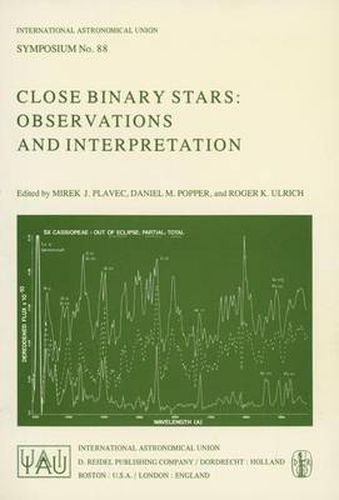Readings Newsletter
Become a Readings Member to make your shopping experience even easier.
Sign in or sign up for free!
You’re not far away from qualifying for FREE standard shipping within Australia
You’ve qualified for FREE standard shipping within Australia
The cart is loading…






This title is printed to order. This book may have been self-published. If so, we cannot guarantee the quality of the content. In the main most books will have gone through the editing process however some may not. We therefore suggest that you be aware of this before ordering this book. If in doubt check either the author or publisher’s details as we are unable to accept any returns unless they are faulty. Please contact us if you have any questions.
Symposium No. 88 of the International Astronomical Union was devoted to a comprehensive review of all types of close.binary stars. The nine sessions were organized according to the type of the objects to be discussed. We have preserved this system, but assembled twelve papers of a more general character (reviews and surveys) into a special chapter placed at the beginning of this book. We would like to remind the reader that the Symposium was preceded by the IAU Colloquium No. 53 on White Dwarfs and Variable Degenerate Stars , and that the sessions on Cataclysmic Variables and related topics at the two meetings supplemented each other. The discussion in Toronto was carefully recorded by Mr. Robert Gauthier. We also wish to thank Mr. Robert O'Daniel, Ms. Joan Kaufmann, and Ms. Linda Reimers for assisting us with the editorial work. M. J. Plavec D. M. Popper R. K. Ulrich ACKNOWLEDGEMENTS The International Astronomical Union and the University of Toronto contributed substantial funds enabling a number of participants to receive travel grants. The Symposium was sponsored by the following Commissions of the International Astronomical Union: 29 (Stellar Spectra), 30 (Radial Velocities), 35 (Stellar Structure), 42 (Close Binary Stars), and 44 (Astronomy from Space). Our special thanks go to the members of the Scientific Organizing Committee. The Symposium was attended by 170 participants from 26 countries.
$9.00 standard shipping within Australia
FREE standard shipping within Australia for orders over $100.00
Express & International shipping calculated at checkout
This title is printed to order. This book may have been self-published. If so, we cannot guarantee the quality of the content. In the main most books will have gone through the editing process however some may not. We therefore suggest that you be aware of this before ordering this book. If in doubt check either the author or publisher’s details as we are unable to accept any returns unless they are faulty. Please contact us if you have any questions.
Symposium No. 88 of the International Astronomical Union was devoted to a comprehensive review of all types of close.binary stars. The nine sessions were organized according to the type of the objects to be discussed. We have preserved this system, but assembled twelve papers of a more general character (reviews and surveys) into a special chapter placed at the beginning of this book. We would like to remind the reader that the Symposium was preceded by the IAU Colloquium No. 53 on White Dwarfs and Variable Degenerate Stars , and that the sessions on Cataclysmic Variables and related topics at the two meetings supplemented each other. The discussion in Toronto was carefully recorded by Mr. Robert Gauthier. We also wish to thank Mr. Robert O'Daniel, Ms. Joan Kaufmann, and Ms. Linda Reimers for assisting us with the editorial work. M. J. Plavec D. M. Popper R. K. Ulrich ACKNOWLEDGEMENTS The International Astronomical Union and the University of Toronto contributed substantial funds enabling a number of participants to receive travel grants. The Symposium was sponsored by the following Commissions of the International Astronomical Union: 29 (Stellar Spectra), 30 (Radial Velocities), 35 (Stellar Structure), 42 (Close Binary Stars), and 44 (Astronomy from Space). Our special thanks go to the members of the Scientific Organizing Committee. The Symposium was attended by 170 participants from 26 countries.